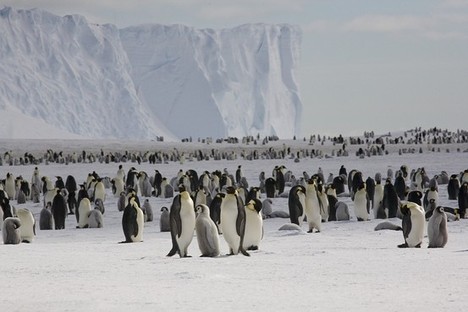 “Using satellites, researchers counted Antarctica’s emperor penguins at 46 colonies like this one near the Halley Research Station, finding numbers twice as high as previously thought.” Source of caption and photo: online version of the WSJ article quoted and cited below.
“Using satellites, researchers counted Antarctica’s emperor penguins at 46 colonies like this one near the Halley Research Station, finding numbers twice as high as previously thought.” Source of caption and photo: online version of the WSJ article quoted and cited below.
(p. A2) Antarctica has twice as many emperor penguins as scientists had thought, according to a new study using satellite imagery in the first comprehensive survey of one of the world’s most iconic birds.
British and U.S. geospatial mapping experts reported Friday in the journal PLoS One that they had counted 595,000 emperor penguins living in 46 colonies along the coast of Antarctica, compared with previous estimates of 270,000 to 350,000 penguins based on surveys of just five colonies. The researchers also discovered four previously unknown emperor-penguin colonies and confirmed the location of three others.
“It is good news from a conservation point of view,” said geographer Peter Fretwell at the British Antarctic Survey in Cambridge, England, who led the penguin satellite census. “This is the first comprehensive census of a species taken from space.”
Although all of Antarctica’s wildlife is protected by international treaty, the emperor penguins are not an officially endangered species. But they are considered a bellwether of any future climate changes in Antarctica because their icy habitat is so sensitive to rising temperatures.
For the full story, see:
ROBERT LEE HOTZ. “Emperor Penguins Are Teeming in Antarctica.” The Wall Street Journal (Sat., April 14, 2012): A2.
(Note: the online version of the story has the date April 13, 2012.)
